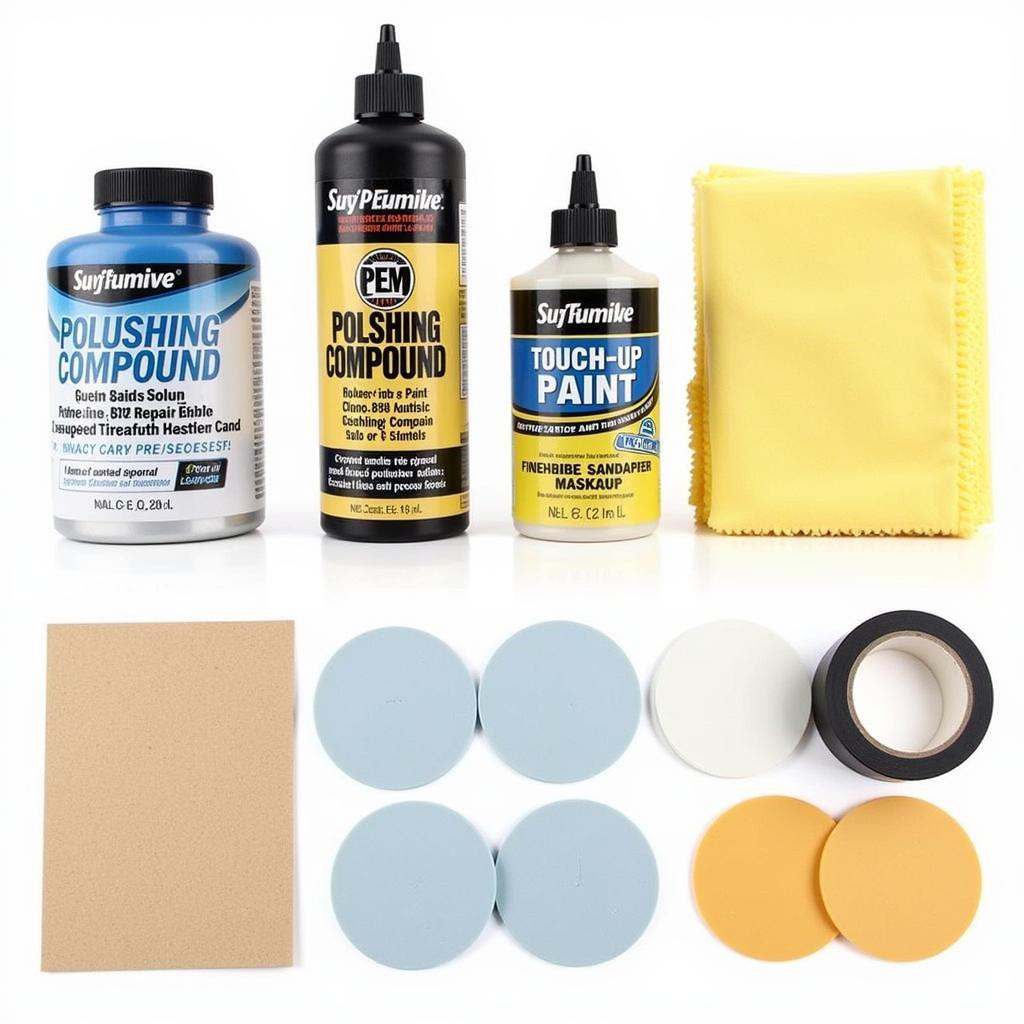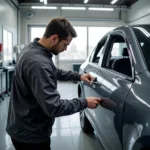Fixing a paint scrape on your car can be a surprisingly manageable DIY project. Whether you grazed a wall in the garage or encountered an unexpected brush with a rogue shopping cart, this guide offers practical solutions for tackling paint scrapes at home, saving you time and money.
Dealing with a paint scrape can be frustrating, but knowing the right approach can make a huge difference. We’ll cover everything from assessing the damage to selecting the appropriate repair method, ensuring you achieve a professional-looking finish without breaking the bank. Learn how to repair minor paint scrapes effectively with our comprehensive guide. car paint scuff repair
Assessing the Damage: How Deep is the Scrape?
Before you begin any repairs, it’s crucial to determine the severity of the scrape. Is it a superficial scratch that only affects the clear coat, or has it penetrated deeper, exposing the base coat or even the primer? This assessment will guide you towards the most appropriate repair method.
Clear Coat Scratches: A Simple Fix
Clear coat scratches are often barely visible and can be remedied with a rubbing compound or polishing compound. These compounds contain fine abrasives that gently level the clear coat, eliminating the appearance of the scratch.
Base Coat Scratches: A Touch-Up Approach
Scratches that reach the base coat require a slightly more involved approach. Touch-up paint pens or bottles are your go-to solution here. Precise application and careful blending are key to achieving a seamless repair.
Primer or Metal Exposure: Seek Professional Help
If the scrape has exposed the primer or the metal underneath, it’s best to consult a professional. These deeper scrapes require specialized tools and techniques to prevent rust and ensure a long-lasting repair. For more complex paint issues, see our guide on repairing loose car paint. repair loose car paint
DIY Paint Scrape Repair: Step-by-Step Guide
For minor paint scrapes affecting the clear coat or base coat, you can achieve excellent results with a DIY approach. Here’s a step-by-step guide to help you through the process:
- Clean the Area: Thoroughly wash and dry the affected area to remove any dirt or debris.
- Assess the Depth: Determine whether the scrape is in the clear coat or the base coat.
- Apply Rubbing Compound (Clear Coat Scratches): Using a microfiber cloth, apply a small amount of rubbing compound to the scratch in a circular motion.
- Buff and Polish: Buff the area with a clean microfiber cloth until the scratch disappears.
- Apply Touch-Up Paint (Base Coat Scratches): If the scratch has reached the base coat, carefully apply touch-up paint using a fine-tipped brush or touch-up pen.
- Level and Blend: After the touch-up paint dries, use a fine-grit sandpaper to level the area and blend the paint with the surrounding finish.
- Apply Clear Coat (Optional): For added protection and shine, apply a thin layer of clear coat over the repaired area. For tips on fixing scratches, refer to our guide on car paint scratch repair. how to repair scratches in car paint
Essential Tools and Materials
Having the right tools and materials at hand is crucial for a successful paint scrape repair. Here’s what you’ll need:
- Rubbing compound
- Polishing compound
- Touch-up paint (matching your car’s color)
- Fine-grit sandpaper
- Microfiber cloths
- Masking tape (optional)
- Applicator pads (optional)
 Essential Tools for DIY Car Paint Repair
Essential Tools for DIY Car Paint Repair
When to Call a Professional
While minor paint scrapes can often be tackled at home, some situations warrant professional intervention. Deep scrapes that expose the primer or metal require expertise to prevent rust and ensure a proper, long-lasting repair. You can find excellent resources for mobile car paint repair, particularly in areas like Doncaster. doncaster mobile car paint repair Also, if you’re unsure about any step of the process, or if the damage appears more extensive than you initially thought, consulting a professional is always the best course of action. Choosing the right repair method is essential for optimal results. For a detailed guide on selecting the best repair strategy, refer to our article on repairing car paint damage. best way to repair car paint damage
“Addressing paint scrapes promptly is vital to prevent further damage and maintain your car’s appearance,” says automotive expert, Michael Davies. “A small investment in DIY repairs or a professional consultation can save you from costly repairs down the line.”
Conclusion
Repairing a paint scrape on your car at home can be a satisfying and cost-effective endeavor. By carefully assessing the damage and following the appropriate repair techniques, you can restore your car’s finish to its former glory. Remember, a timely paint scrape repair is an investment in your vehicle’s longevity and aesthetic appeal.
FAQ
- Can I use toothpaste to repair a paint scrape? While toothpaste might seem like a quick fix, it’s not recommended for car paint repair.
- How long does touch-up paint take to dry? Touch-up paint typically dries within 30 minutes to an hour, depending on the brand and environmental conditions.
- What is the difference between rubbing compound and polishing compound? Rubbing compound is more abrasive and used to remove deeper scratches, while polishing compound is finer and used to restore shine.
- Can I wax my car after repairing a paint scrape? Yes, you can wax your car after the repaired area has fully cured.
- How do I match my car’s paint color for touch-up paint? Your car’s paint code can usually be found on a sticker inside the driver’s side door jamb or in your owner’s manual.
If you need assistance, please contact us via WhatsApp: +1(641)206-8880, or Email: cardiagtechworkshop@gmail.com. Our customer support team is available 24/7.

